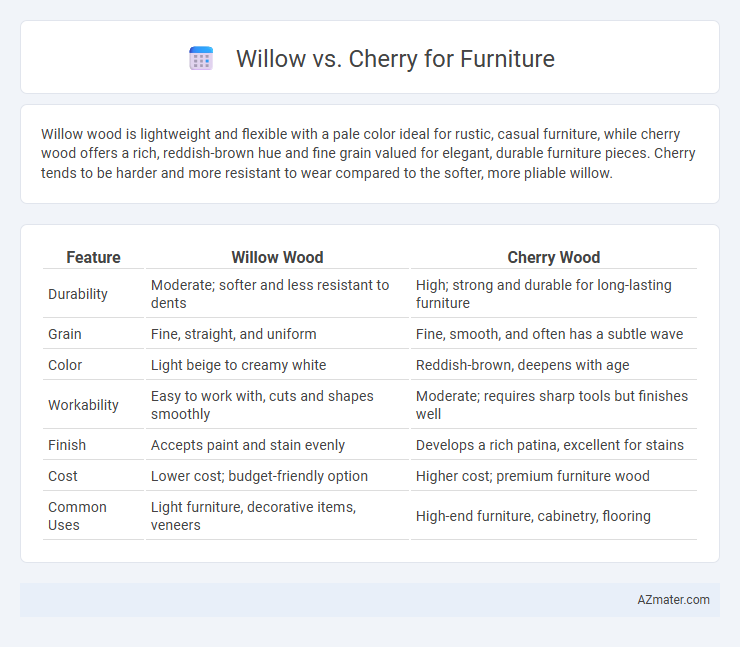Willow wood is lightweight and flexible with a pale color ideal for rustic, casual furniture, while cherry wood offers a rich, reddish-brown hue and fine grain valued for elegant, durable furniture pieces. Cherry tends to be harder and more resistant to wear compared to the softer, more pliable willow.
Table of Comparison
| Feature | Willow Wood | Cherry Wood |
|---|---|---|
| Durability | Moderate; softer and less resistant to dents | High; strong and durable for long-lasting furniture |
| Grain | Fine, straight, and uniform | Fine, smooth, and often has a subtle wave |
| Color | Light beige to creamy white | Reddish-brown, deepens with age |
| Workability | Easy to work with, cuts and shapes smoothly | Moderate; requires sharp tools but finishes well |
| Finish | Accepts paint and stain evenly | Develops a rich patina, excellent for stains |
| Cost | Lower cost; budget-friendly option | Higher cost; premium furniture wood |
| Common Uses | Light furniture, decorative items, veneers | High-end furniture, cabinetry, flooring |
Introduction to Willow and Cherry Wood
Willow and cherry woods are prized materials in furniture making, each offering unique characteristics that influence design and durability. Willow wood is lightweight and flexible, making it ideal for intricate, carved details and rustic styles. Cherry wood is renowned for its rich, reddish-brown hue and smooth grain, providing elegant finishes and excellent aging qualities in high-end furniture.
Physical Characteristics: Willow vs Cherry
Willow wood is lightweight with a fine, smooth texture and a pale, creamy color that darkens with age, making it ideal for intricate carvings and rustic furniture styles. Cherry wood boasts a medium density and a rich reddish-brown hue that deepens over time, known for its smooth grain and durability, perfect for elegant and traditional furniture pieces. Both woods offer distinct aesthetics and physical properties, with willow providing flexibility and lightness, while cherry emphasizes strength and a warm, polished finish.
Durability and Longevity Comparison
Willow wood offers moderate durability with a Janka hardness rating around 430, making it softer and more prone to dents and scratches compared to cherry wood, which has a higher Janka hardness of approximately 950. Cherry wood is known for its exceptional longevity, developing a rich patina over time and resisting wear, making it ideal for high-use furniture pieces. In terms of long-term investment, cherry furniture typically remains structurally sound and aesthetically appealing for decades, whereas willow furniture may require more maintenance and care to ensure durability.
Workability and Crafting Ease
Willow wood offers excellent workability with its soft texture and fine grain, making it ideal for detailed carving and shaping in furniture crafting. Cherry wood, while denser and harder, provides smooth sanding and finishes beautifully, though it requires more skill and sharper tools for precise work. Craftsmen often prefer willow for ease of handling and cherry for its durability and rich aesthetic in finished furniture pieces.
Appearance and Color Variations
Willow wood features a light, creamy color with subtle grain patterns, giving furniture a soft and natural appearance ideal for casual or rustic styles. Cherry wood offers rich, warm reddish-brown hues that deepen and darken with age, providing a classic and elegant look favored in traditional and high-end furniture. Both woods present distinct aesthetic appeal, with willow's pale tones enhancing brightness and cherry's color variations adding depth and sophistication.
Cost and Availability Factors
Willow furniture tends to be more affordable than cherry due to its faster growth rate and greater availability in many regions, making it a cost-effective choice for budget-conscious buyers. Cherry wood, known for its rich color and durability, often comes at a higher price point because it is less abundant and takes longer to mature. Availability of cherry furniture can be limited depending on geographic location, whereas willow is more widely accessible in both raw and finished forms.
Sustainability and Environmental Impact
Willow wood offers high sustainability due to its fast growth and regenerative cultivation, making it an eco-friendly choice for furniture production with lower carbon footprints. Cherry wood, while prized for durability and rich color, grows slower and requires more extended harvesting periods, leading to increased environmental impact. Choosing willow over cherry supports sustainable forestry practices and reduces deforestation concerns linked to slow-growing hardwood species.
Common Applications in Furniture
Willow wood offers flexibility and lightweight properties, making it ideal for crafting bentwood furniture such as rocking chairs and woven baskets. Cherry wood is prized for its rich color and durability, frequently used in high-end cabinetry, dining tables, and intricate woodwork. Both woods provide unique aesthetic and functional qualities suited to distinct furniture applications.
Maintenance and Care Tips
Willow furniture requires regular dusting and occasional polishing to maintain its natural sheen, while avoiding excessive moisture to prevent warping. Cherry wood needs periodic cleaning with a soft cloth and special wood polish to enhance its rich color and protect the finish from sun damage. Both woods benefit from stable humidity levels and protective pads under furniture legs to reduce wear and extend longevity.
Final Verdict: Which Wood is Better for Furniture?
Willow offers lightweight and flexible properties, making it suitable for rustic or decorative furniture, while cherry wood boasts exceptional durability, rich color, and fine grain ideal for high-quality, long-lasting pieces. Cherry wood's strength and natural resistance to wear outperform willow's softer texture, which is prone to dents and scratches over time. Therefore, cherry is generally the better choice for furniture requiring strength, elegance, and longevity.

Infographic: Willow vs Cherry for Furniture
 azmater.com
azmater.com